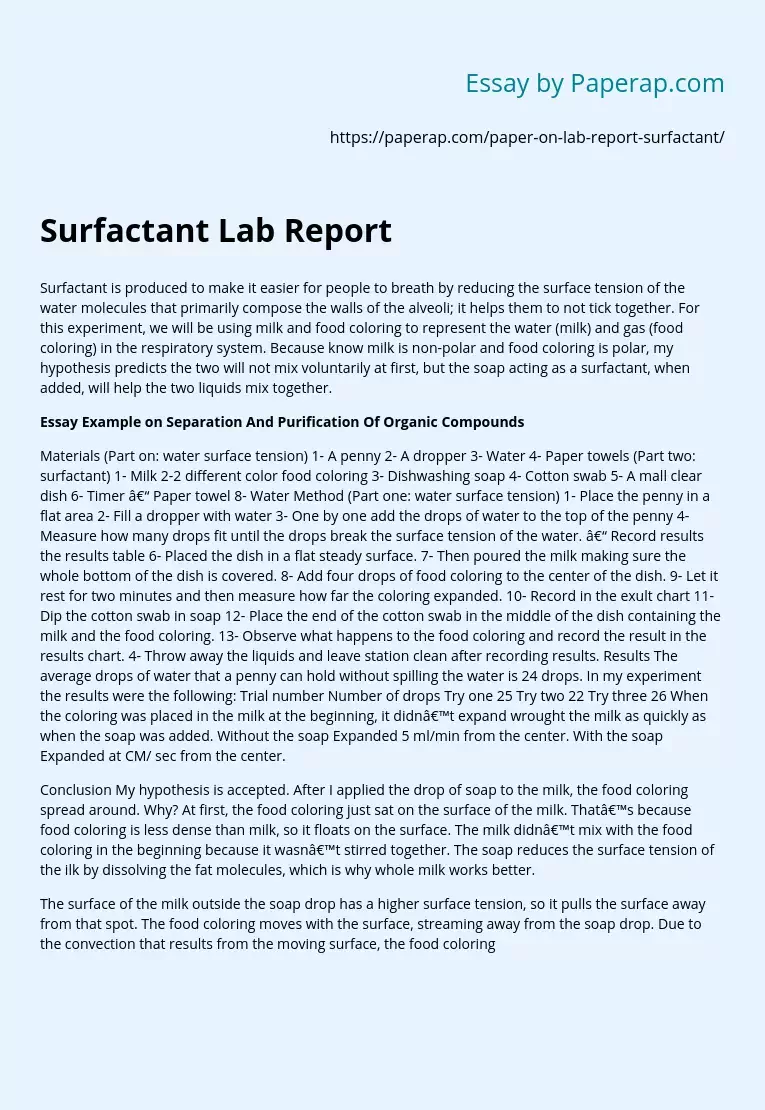Surfactant Lab Report
Surfactant is produced to make it easier for people to breath by reducing the surface tension of the water molecules that primarily compose the walls of the alveoli; it helps them to not tick together. For this experiment, we will be using milk and food coloring to represent the water (milk) and gas (food coloring) in the respiratory system. Because know milk is non-polar and food coloring is polar, my hypothesis predicts the two will not mix voluntarily at first, but the soap acting as a surfactant, when added, will help the two liquids mix together.
Essay Example on Separation And Purification Of Organic Compounds
Materials (Part on: water surface tension) 1- A penny 2- A dropper 3- Water 4- Paper towels (Part two: surfactant) 1- Milk 2-2 different color food coloring 3- Dishwashing soap 4- Cotton swab 5- A mall clear dish 6- Timer – Paper towel 8- Water Method (Part one: water surface tension) 1- Place the penny in a flat area 2- Fill a dropper with water 3- One by one add the drops of water to the top of the penny 4- Measure how many drops fit until the drops break the surface tension of the water.
– Record results the results table 6- Placed the dish in a flat steady surface. 7- Then poured the milk making sure the whole bottom of the dish is covered. 8- Add four drops of food coloring to the center of the dish. 9- Let it rest for two minutes and then measure how far the coloring expanded.
10- Record in the exult chart 11- Dip the cotton swab in soap 12- Place the end of the cotton swab in the middle of the dish containing the milk and the food coloring. 13- Observe what happens to the food coloring and record the result in the results chart. 4- Throw away the liquids and leave station clean after recording results. Results The average drops of water that a penny can hold without spilling the water is 24 drops. In my experiment the results were the following: Trial number Number of drops Try one 25 Try two 22 Try three 26 When the coloring was placed in the milk at the beginning, it didn’t expand wrought the milk as quickly as when the soap was added. Without the soap Expanded 5 ml/min from the center. With the soap Expanded at CM/ sec from the center.
Conclusion My hypothesis is accepted. After I applied the drop of soap to the milk, the food coloring spread around. Why? At first, the food coloring just sat on the surface of the milk. That’s because food coloring is less dense than milk, so it floats on the surface. The milk didn’t mix with the food coloring in the beginning because it wasn’t stirred together. The soap reduces the surface tension of the ilk by dissolving the fat molecules, which is why whole milk works better.
The surface of the milk outside the soap drop has a higher surface tension, so it pulls the surface away from that spot. The food coloring moves with the surface, streaming away from the soap drop. Due to the convection that results from the moving surface, the food coloring may be drawn down into the liquid, only to appear rising again somewhere else. When the soap finally gets evenly mixed into the milk, the action stops.
Surfactant Lab Report. (2019, Nov 27). Retrieved from https://paperap.com/paper-on-lab-report-surfactant/

